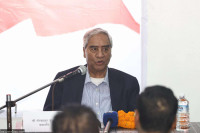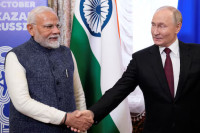Opinion
Wrong model
Development model pursued by the government is perpetuating inequality bias
Khilendra Basnyat
Economic development is defined as a rise in the level of living of the ordinary people. But over time, it has become a major political issue in most developing and least developed countries. In recent times, the whole of East Asia has achieved some exceptional economic growth; while China is moving at a momentous rate. Similarly, the economy of India is gaining speed, too, showing a remarkable sign of change. Yet, back home, the development model pursued by the government is perpetuating inequality bias. The model is based on centre-periphery relationship, demand management, and a high dependency on India. Economic dualism is the chief factor in such model.
In consonance with the surge of globalisation, Nepal’s economy was liberalised some years ago expecting much headway in the economic development front. In this context, some laws were formulated to attract foreign direct investment and promote joint ventures. By doing so, it was expected that more foreign investment will be poured in Nepal and its competitive capacity will be enhanced. But since laws were not investment-friendly, things did not turn out to be as expected. Some economists are of the opinion that liberalisation has promoted import trade here but not export. The process of growing globalisation and regionalisation has given rise to competition among countries. Owing to this, people with power became more affluent while the weaker ones were further marginalised.Although liberalisation has been adopted in Nepal’s polity, regrettably, there is no clarity regarding choice of options and trade-off between inter-sectorial and intra-sectorial priorities. Despite the fact that some growth is necessary to sustain the economy; it alone does not guarantee equity and social justice as much as expected.
Nepal’s overall development demands growth equity, but economic and non-economic factors play a significant role while pursuing various kinds of development goals. Actually, the principles of economy do not work because every society has its own specialty and features. In Nepal, the pattern of development and the structure of socio-economic relations have not been appropriately planned as yet; consequently, they do not result in appreciable increases in national income and employment. The absence of an established link between priorities and policies was a major drawback of the old strategy. As a result, the instruments selected to achieve these priorities failed to deliver although the priorities were clear. In recent years too, there has been no satisfactory link between priorities and policies. And still, very little is done in this regard. In fact, lack of resources, poor infrastructures, small domestic market, competition from India and no access to the sea have hindered Nepal’s economic development for the longest time. According to a study conducted by the World Bank and the United Nations Development Program a few years ago, the poverty incidence here is high as compared to developed countries. For the poorest, the problems have been intensified by social and cultural aspects such as corruption, nepotism and inefficient bureaucracy.
In the past, efforts were made through different plans and programmes to create a variable economy here. However, the gap between targets and achievements widened, rendering the plans and programmes unsuccessful. After the reestablishment of democracy, there has been a big jump in price rise, scarcity and unemployment. There has also been a high degree of politicisation of different issues relating to economic development. For this reason, economic development could not take pace as expected.
Since 1956 Nepal has followed a series of economic models, experimenting one after another. However, all of them failed due to the blind imitation of the development models of other countries. Context and the ground reality matter as much when deciding on any development model to be adopted. But our policymakers have paid scant attention to this fact. As Nepal cannot afford to be an island of decay in this sea of growth, it will have to measure upto the challenge of rapid economic growth as soon as possible. Although different sectors contribute to the increase in the GDP in Nepal, it is the improvement in the agricultural sector that can bring about the most substantial changes. Moreover, there should be a growth trend in services and manufacturing sectors. But, the authorities concerned have not paid attention to this fact as of yet.
The present global economic situation is a matter of serious concern to all. Many developing and least developed countries have taken special initiatives to attract foreign investment to expedite economic development, and Nepal should also take concrete steps in this regard.
The economic agenda for sustainable, non-inflationary and export-led growth cannot be done in isolation. Hence, it warrants an environment of participatory democracy. Also, since Nepali economy is not capable of looking after itself, it needs state support in the form of institution building, training and infrastructure development for which an efficient private sector’s participation is essential. Apart from this, it goes without saying, a committed political leadership is indispensable for developing a sustainable economy.
Basnyat is a freelance writer.




 14.12°C Kathmandu
14.12°C Kathmandu








%20(1).jpg&w=300&height=200)

